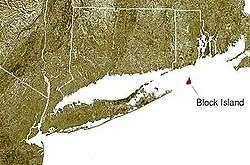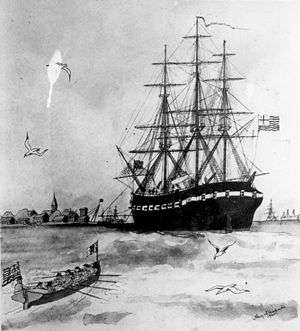Battle of Block Island
| ||||||||||||||||||||||||||||||
The Battle of Block Island was a night-time naval encounter that took place during the American Revolutionary War between the Continental Navy on April 6th, 1776. It was returning from a successful raid on Nassau in The Bahamas, and HMS Glasgow, a Royal Navy dispatch boat. Glasgow escaped captivity by the fleet of seven ships under the command of Commodore Esek Hopkins, despite the ship sustaining significant damage during the encounter.
Several of the ship's captains of the Continental fleet were criticized for their actions during the battle, and one was dismissed as a result. Commodore Hopkins was criticized for other actions pertaining to the cruise, including the distribution of seized goods, and was eventually also dismissed from the Navy. One of the first encounters at sea did not go well for the fledgling U.S. fleet. Known as the Battle of Block Island, this small skirmish took place off the waters of Rhode Island. The battle played out during the night under bright moonlight, and is considered a victory for the British.[3]
Background
HMS Glasgow was a sixth-rate 20-gun frigate of the Royal Navy. In early April 1776, under the command of navy captain Tryingham Howe,[4] the ship was carrying dispatches from Newport, Rhode Island to the British fleet off Charleston, South Carolina.[5] This fleet had been assembled to launch an assault on Charleston, which ultimately failed in the June Battle of Sullivan's Island.[6]
The Second Continental Congress had established the Continental Navy in late 1775.[7] By February 1776 the first ships of the fleet were ready for their maiden voyage, and Commodore Esek Hopkins led a fleet of eight ships on an expedition to the Bahamas, where the British were known to have military stores. In early March, the fleet (reduced by one due to tangled riggings en route) landed marines on the island of New Providence and captured the town of Nassau.[8][9] After loading the fleet's ships, now including two captured prize ships, with military stores, the fleet sailed north on March 17. One ship was dispatched to Philadelphia, while the rest of the fleet sailed for the Block Island channel.[10] The fleet's cruise was marked by outbreaks of a variety of diseases, including fevers and smallpox, resulting in significant reductions in crew effectiveness.[1]
By April 4, the fleet had reached the waters off Long Island, and captured a prize, HMS Hawk, which was also laden with supplies. The next day brought a second prize, the Bolton.[11] Hoping to catch more easy prizes, Hopkins continued to cruise off Block Island that night, organizing the fleet into a scouting formation of two columns. The right, or eastern, column was headed by the USS Cabot, followed by Hopkins' flagship, the USS Alfred, which, at 20 guns, was the largest ship of the fleet. The left column was headed by the USS Andrew Doria, followed by the USS Columbus. Behind these came the USS Providence, with USS Fly and USS Wasp trailing further behind as escorts for the prizes.[5] The need to provide crews for the prize ships further reduced the fighting effectiveness of the fleet.[1]
Battle

The battle took place on an exceptionally clear night with a nearly full moon. Between 1 and 2 A.M. on April 6, with the fleet headed in a generally southerly direction, Andrew Doria and Glasgow spotted each other about 8 leagues (20 to 24 nautical miles) southeast of Block Island.[12][13] Glasgow was heading west, destined for Charleston. Captain Howe came about to investigate the fleet, and over the next 30 minutes closed to within hailing distance. Commodore Hopkins gave no signals during this time, so the fleet formed no battle line. This resulted in a battle that Captain Nicholas Biddle of the Andrew Doria later described as "helter-skelter".[5]
Howe first came upon the Cabot, whose captain was Esek Hopkins' son, John. The younger Hopkins, when hailed for identification, replied, "The Columbus and Alfred, a 22-gun frigate."[4] An overzealous seaman on his ship then tossed a grenade onto the Glasgow's deck, and the battle was engaged.[4] Cabot, a lightly armed brig, fired one ineffective broadside of six-pounders. Glasgow countered with two broadsides with its heavier weaponry, killing Cabot's master, wounding Hopkins, and disabling the ship's steering. As she drifted away, the Alfred came up to engage Glasgow, and the two engaged in a broadside duel. A shot from Glasgow early in the action broke the lines to Alfred's tiller; her temporary loss of steering exposed her to raking fire. Her drift also made it difficult for the Andrew Doria to join the action, as the ship also had to maneuver to avoid the drifting Cabot.[14] The Providence held back, and Columbus was eventually able to join the action late, but her fire was so wild that little to no damage was done to Glasgow.[15]
With Glasgow now exposed to fire from three ships, Howe decided to break off the battle in order to avoid being boarded, and made sail for Newport. Despite extensive damage to sail and rigging, he pulled away from the pursuing fleet, which was fully laden with its captured goods.[4] After several hours of chase lasting into daylight, Hopkins called off the chase to avoid an encounter with the British squadron at Newport. His only prize was Glasgow's tender,[1] which the fleet brought to anchor in New London, Connecticut on April 8.[16]
Aftermath
The Glasgow suffered only four casualties (one killed and three wounded). This count demonstrated the poor quality of the Continental fleet's gunnery. All of the casualties were injured due to musket fire.[1] Aboard the Cabot there were four killed and seven wounded. The Alfred had six killed and six wounded. Andrew Doria's drummer was also wounded.[2]

Although Continental Congress President John Hancock praised Hopkins for the fleet's performance, its failure to capture the Glasgow gave opponents of the Navy in and out of Congress opportunities for criticism. Nicholas Biddle wrote of the action, "A more imprudent, ill-conducted affair never happened."[17] Abraham Whipple, captain of the Columbus, endured rumors and accusations of cowardice for a time, but eventually asked for a court martial to clear his name. Held on May 6th 1766 by a panel consisting of officers who had been on the cruise, he was cleared of cowardice, although he was also criticized for errors of judgment.[18] John Hazard, captain of the Providence, was not so fortunate. Charged with a variety of offenses by his subordinate officers, including neglect of duty during the Glasgow action, he was convicted by court martial and forced to surrender his commission.[19]
Commodore Hopkins came under scrutiny from Congress over matters unrelated to this action. He had violated his written orders in sailing to Nassau instead of Virginia and the Carolinas, and he had distributed the goods taken during the cruise to Connecticut and Rhode Island without consulting Congress.[20] He was censured for these transgressions. In January 1778, Hopkins was dismissed from the Navy after further controversies, including the fleet's failure to sail again (a number of its ships suffered from crew shortages, and also became trapped at Providence, Rhode Island by the British occupation of Newport late in 1776).[21]
Glasgow, suffering from the battle and having dumped her dispatches, returned to Newport. She was found to be in bad shape that she was made as seaworthy as possible and sent to Portsmouth for repairs. Her mission was reassigned to HMS Nautilus, another ship in the Newport squadron.[22]
Notes
- 1 2 3 4 5 Morgan, p. 44
- 1 2 Coggins, p. 29
- ↑ "Battle of Block Island (April 6, 1776) Summary & Facts". totallyhistory.com. Retrieved 2016-12-01.
- 1 2 3 4 Morgan, p. 43
- 1 2 3 Morison, p. 70
- ↑ Greene, p. 184
- ↑ Morison, pp. 57–58
- ↑ Morison, pp. 67–68
- ↑ Field, p. 117
- ↑ Field, pp. 118–119
- ↑ Field, p. 120
- ↑ The Gentleman's Magazine, p. 259
- ↑ Morison, pp. 70–71
- ↑ Morison, p. 72
- ↑ Morison, p. 73
- ↑ Morgan, p. 45
- ↑ Thomas, p. 52
- ↑ Morgan, p. 47
- ↑ Morgan, pp. 47–48
- ↑ Morgan, p. 49
- ↑ Morgan, pp. 49–52
- ↑ Clarke, Volume 4, pp. 681,1157
References
- Clark, William Bell, ed. (1970). Naval Documents of the American Revolution (PDF). Volume 4. Washington: US Department of the Navy. OCLC 469688874.
- Coggins, Jack (2002). Ships and Seamen of the American Revolution. Mineola, NY: Courier Dover. ISBN 978-0-486-42072-1. OCLC 48795929.
- Field, Edward (1898). Esek Hopkins, Commander-in-Chief of the Continental Navy During the American Revolution, 1775 to 1778. Providence, RI: Preston & Rounds. OCLC 3430958.
- Greene, Francis Vinton (1911). The Revolutionary War and the military policy of the United States. New York: C. Scribner's Sons. OCLC 952029.
- Morgan, William James (1959). Captains to the Northward. Barre, MA: Barre Publishing. OCLC 1558276.
- Morison, Samuel Eliot (1999) [1959]. John Paul Jones: A Sailor's Biography. Annapolis, MD: Naval Institute Press. ISBN 978-1-55750-410-4. OCLC 42716061.
- Thomas, Evan (2004). John Paul Jones: Sailor, Hero, Father of the American Navy. New York: Simon and Schuster. ISBN 978-0-7432-5804-3. OCLC 56321227.
- The Gentleman's Magazine, Volume 46. London: D. Henry. 1776. OCLC 1570611. (reprints Howe's report)

